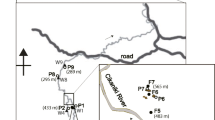Abstract
British Columbia is commonly considered to be highly mercuriferous. Regional plant-soil Hg distribution patterns in B.C. and adjacent Alberta distinguish not only Hg-rich sites with histories of thermal activity, but also many more sites with Hg-levels at or below reference levels established at Prince George. In the Fort St. James-Pinchi Lake area nearby, environmental Hg sources include residues from a now abandoned but once productive mine, and ore bodies from the extensive Pinchi Fault system lode deposits. In the study of plant-soil Hg relations in this area horsetail, plantain and dandelion were found to be useful indicator plants. In addition however, samples of aquatic macrophytes, waters, sediments, and air were taken to broaden the picture of plant-environment Hg distribution.
After comparing our findings with various mine/smelter and other emission models, we concluded that mining activities were intensely polluting locally but the polluting species were not highly mobile. Elsewhere in the Fort St. James area, distribution patterns point to many low level widely dispersed sources, possibly the result of both re-emission of bioaccumulated Hg and its degassing from Pinchi fault deposits.
Similar content being viewed by others
References
Anderson, A.: 1979, in Nriagu, J. (ed.), The Biogeochemistry of Mercury in the Environment, Elsevier/North Holland Biomedical Press, Amsterdam, pp. 80–112.
Armstrong, J.: 1948, Map 907A. Fort St. James, British Columbia Canada, Department of Mines and Resources, Geological Survey of Canada, Ottawa.
Armstrong, J.: 1949, Fort St. James Map-Area, Cassiar and Coast Districts, British Columbia, Department of Mines and Technical Surveys, Geological Survey of Canada, Ottawa.
Bryne, A. and Kosta, L.: 1970, Vestu. Slov. Kem. Drus. 17, 5.
Cameron, A. and Nickles, S.: 1979, Water, Air, and Soil Pollut. 11, 253.
Cannon, H., Shacklette, H., and Bastron, H.: 1968, U.S. Geol. Survey Bull. 1278-A.
Connor, J.: 1979, Sci. of Total Env. 12: 241.
Connor, J., Keith, J. and Anderson, B.: 1976, J. Res. U.S. Geol. Survey. 4, 49.
Fleischer, M.: 1970, in Mercury in the Environment, U.S. Geol. Survey Prof. Paper 713, pp. 6–8.
Folkeson, L.: 1979, Water, Air, and Soil Pollut. 11, 253.
Gardner, D.: 1975, Mar. Pollut. Bull. 6, 43.
Glooshenko, W. and Capobianco, J.: 1978, Water, Air, and Soil Pollut. 10, 215.
Hildebrand, S., Huckabee, J., Diaz, F., Janzen, S., Solomon, A., and Kumar, K.: 1980, Distribution of Mercury in the Environment at Almaden, Spain, Oak Ridge National Laboratory, ORNL/TM-7446, Env. Sci. Div. Publ. 1570.
Joensuu, O.: 1971, Science 172, 1027.
John, M., Van Laerhoven, C., Osborne, V., and Cotic, L.: 1975, Water, Air, and Soil Pollut. 5, 213.
Lockeretz, W.: 1974, Water, Air, and Soil Pollut. 3, 179.
McCarthy, J., Meuschke, J., Ficklin, W., and Learned, R.: 1970, in Mercury in the Environment, U.S. Geol. Survey Prof. Paper 713, pp. 37–39.
Pierce, A., Botbol, J., and Learned, R.: 1970, in Mercury in the Environment, U.S. Geol. Survey Prof Paper 713, pp. 14–16.
Piotrowski, J. and Coleman, D.: 1980, Environmental Hazards of Heavy Metals: Summary Evaluation of Lead, Cadmium and Mercury, Marc Report 20, Monitoring and Research Assessment Centre, London.
Siegel, B. and Siegel, S.: 1982, Science 210, 292.
Siegel, B. Siegel, S., and Horsky, S.: 1984, Env. Sci. Technol (in press).
Siegel, F.: 1976, Applied Geochemistry, Wiley-Interscience, New York, pp. 121–151.
Siegel, S., Puerner, N., and Speitel, T.: 1975, Physiol. Plant 32, 174.
Siegel, S. and Siegel, B.: 1984, Organ. Geochem. (in press).
Siegel, S. and Siegel, B.: 1983, Adv. Space Res. 3, 135.
Siegel, S., Siegel, B. and McMurtry, G.: 1980, Water, Air, and Soil Pollut. 13, 109.
Suckcharoen, S.: 1980, Bull. Env. Contam. Toxicol. 24, 463.
Suckcharoen, S.: 1979, Ann. Bot. Fennici 16, 173.
Suckcharoen, S.: 1978, Water, Air, and Soil Pollut. 10, 451.
Wangen, L. and Turner, F.: 1980, Water, Air, and Soil Pollut. 13, 99.
Warren, H., Delavault, R. and Barakso, J.: 1966, Econ. Geol. 61, 1010.
Author information
Authors and Affiliations
Rights and permissions
About this article
Cite this article
Siegel, S.M., Siegel, B.Z., Lipp, C. et al. Indicator plant-soil mercury patterns in a mercury-rich mining area of British Columbia. Water Air Soil Pollut 25, 73–85 (1985). https://doi.org/10.1007/BF00159626
Received:
Revised:
Issue Date:
DOI: https://doi.org/10.1007/BF00159626




